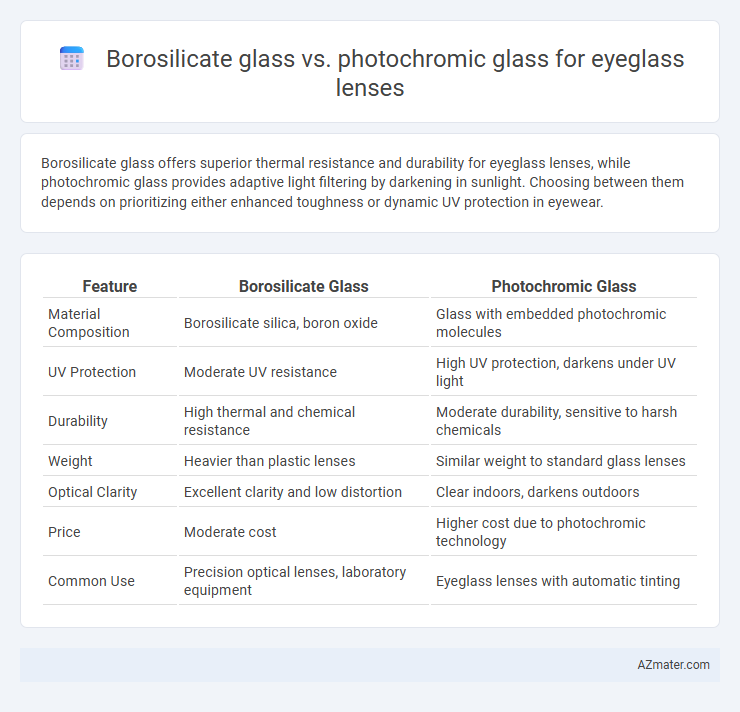Borosilicate glass offers superior thermal resistance and durability for eyeglass lenses, while photochromic glass provides adaptive light filtering by darkening in sunlight. Choosing between them depends on prioritizing either enhanced toughness or dynamic UV protection in eyewear.
Table of Comparison
| Feature | Borosilicate Glass | Photochromic Glass |
|---|---|---|
| Material Composition | Borosilicate silica, boron oxide | Glass with embedded photochromic molecules |
| UV Protection | Moderate UV resistance | High UV protection, darkens under UV light |
| Durability | High thermal and chemical resistance | Moderate durability, sensitive to harsh chemicals |
| Weight | Heavier than plastic lenses | Similar weight to standard glass lenses |
| Optical Clarity | Excellent clarity and low distortion | Clear indoors, darkens outdoors |
| Price | Moderate cost | Higher cost due to photochromic technology |
| Common Use | Precision optical lenses, laboratory equipment | Eyeglass lenses with automatic tinting |
Introduction to Eyeglass Lens Materials
Borosilicate glass, known for its high thermal resistance and scratch durability, is a popular choice for eyeglass lenses requiring long-lasting clarity and strength. Photochromic glass lenses, embedded with light-sensitive molecules, adapt to varying light conditions by darkening in sunlight and clearing indoors, enhancing visual comfort. Both materials offer unique benefits, with borosilicate excelling in durability and photochromic glass providing dynamic light adjustment for wearer convenience.
What is Borosilicate Glass?
Borosilicate glass is a type of glass composed primarily of silica and boron trioxide, known for its superior thermal resistance and durability compared to regular glass. It is highly resistant to chemical corrosion and thermal shock, making it an ideal material for high-quality eyeglass lenses that require clarity and strength. Unlike photochromic glass, which changes tint based on exposure to UV light, borosilicate glass maintains a consistent transparency and is often used in lenses where optical precision and scratch resistance are essential.
Characteristics of Borosilicate Glass Lenses
Borosilicate glass lenses are characterized by their exceptional thermal resistance and high durability, making them resistant to scratches and chemical corrosion. These lenses offer superior optical clarity and minimal refractive distortion, providing crisp vision compared to standard glass or plastic lenses. Their low thermal expansion coefficient ensures stability under temperature fluctuations, enhancing longevity in eyewear applications.
What is Photochromic Glass?
Photochromic glass is a type of eyeglass lens material that darkens automatically in response to ultraviolet (UV) light exposure, providing convenient sun protection without the need to switch lenses. Unlike borosilicate glass, which is known for its high thermal and chemical resistance, photochromic glass combines optical clarity with adaptive light filtering, enhancing visual comfort both indoors and outdoors. This smart lens technology uses embedded molecules that change structure under UV rays, offering dynamic tinting while maintaining durable eyewear performance.
How Photochromic Glass Lenses Work
Photochromic glass lenses contain molecules that react to ultraviolet (UV) light, causing the lenses to darken when exposed to sunlight and return to clear indoors. Borosilicate glass, known for its thermal resistance and durability, does not change tint in response to light. Photochromic technology enhances visual comfort by automatically adjusting lens tint, protecting eyes from UV rays and reducing glare without manual intervention.
Durability and Strength Comparison
Borosilicate glass exhibits superior durability and impact resistance due to its low thermal expansion and high chemical stability, making it less prone to cracking or shattering compared to photochromic glass lenses. Photochromic lenses, typically made from plastic or polycarbonate, offer flexibility and lighter weight but generally have lower scratch resistance and strength than borosilicate glass. The inherent toughness of borosilicate glass ensures longer-lasting lenses, especially in environments with rapid temperature changes or physical stress.
Optical Clarity and Visual Performance
Borosilicate glass offers superior optical clarity due to its low thermal expansion and high resistance to scratches, making it ideal for precise vision and long-lasting lens performance. Photochromic glass provides excellent visual performance by automatically adjusting tint levels in response to UV light, reducing glare and enhancing comfort in varying lighting conditions. While borosilicate glass excels in maintaining consistent clarity, photochromic lenses deliver adaptable vision suited for outdoor and indoor transitions.
UV Protection and Light Adaptability
Borosilicate glass offers exceptional UV protection due to its inherent chemical composition and high resistance to UV radiation, making it highly effective for eyeglass lenses exposed to sunlight. Photochromic glass dynamically adapts to varying light conditions by darkening in response to UV rays, providing both UV protection and enhanced comfort in bright environments. The combination of UV-blocking properties in borosilicate glass and light-adaptive functionality in photochromic lenses ensures superior eye safety and visual clarity under diverse lighting conditions.
Cost and Availability Considerations
Borosilicate glass lenses are generally more affordable due to lower production costs and widespread availability compared to photochromic glass lenses, which involve complex chemical treatments that increase price and limit supply. Photochromic lenses often require specialized manufacturing processes, resulting in higher retail costs and less availability in standard optical stores. Consumers prioritizing budget and ease of replacement typically find borosilicate glass lenses more accessible and cost-effective than photochromic alternatives.
Which Lens Material is Best for You?
Borosilicate glass offers exceptional scratch resistance and optical clarity, making it ideal for users prioritizing durability and sharp vision. Photochromic glass lenses adapt to changing light conditions by darkening outdoors and clearing indoors, perfect for those seeking convenience and UV protection without switching glasses. Choosing between Borosilicate and Photochromic glass depends on individual lifestyle needs: durability and clarity favor Borosilicate, while versatility and light sensitivity management point to Photochromic lenses.

Infographic: Borosilicate glass vs Photochromic glass for Eyeglass lens
 azmater.com
azmater.com